As part of an ongoing census of the birds of Trinity College, we surveyed their diversity just outside our door.
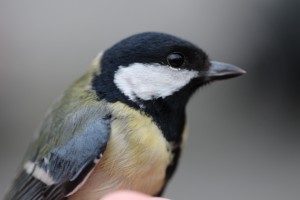
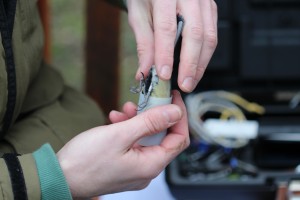

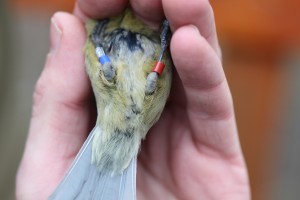


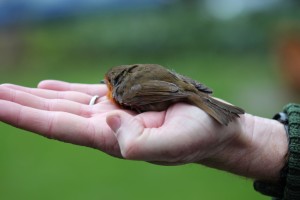
Authors
Trinity College Zoology Students
Photo Credit
Trinity College Zoology Students

Trinity College Dublin, Ecology and Evolution
Understanding how species extinctions affect the stability of ecosystems is fundamental to the prediction of future biodiversity loss and to ensuring the reliable provision of ecosystem services. In a paper published recently in Ecology Letters*, we (researchers from the School of Natural Sciences in Trinity College Dublin and the Trinity Centre for Biodiversity Research, together with collaborators from Northern Ireland, Spain and Switzerland) show that the destabilising effect of biodiversity loss is likely to be considerably greater than thought previously.
Ecosystem stability has been the subject of hundreds, if not thousands, of papers. It occupies a prominent place in both fundamental and applied ecological research. However, ecological stability is regularly touted as a multifaceted and complex concept. This is because there are many different ways in which we can measure the stability of ecosystems. These include, for example, the variability of systems over time or their ability to resist or recover from disturbances. However, in spite of its multifaceted nature, almost all studies focus only on a single measure to characterise ecosystem stability. Further, the few studies that measured more than one component of stability considered them as independent and therefore analysed them separately, in spite of the fact that they are likely to be related to one another.
Using an experimental study done on a marine rocky shore, we examined the effects of the loss of different consumer species, including both predators and their prey, on multiple distinct components of ecological stability simultaneously. We show for the first time that, even though stability is a relatively simple property of ecological communities, different species contribute in different ways to the maintenance of stability. Moreover, our study also demonstrates that the loss of species from ecosystems can modify and even decouple relationships among components of stability. Ignoring the multifaceted nature of stability therefore risks underestimating significantly the potential of perturbations to destabilize ecosystems. In conclusion, our study indicates that we currently underestimate significantly the overall destabilizing effect of biodiversity loss and thus the true scale of the global extinction crisis that we face.
Author
Ian Donohue: ian.donohue@tcd.ie
Photo credit
On the 15th and 16th April we had one of my favourite events at Trinity College Dublin: the annual School of Natural Sciences Postgraduate Symposium. Over the course of two days many of our PhD students presented their work to the School. We also had two amazing plenary talks from Dr Nick Isaac (CEH) and Professor Jennifer McElwain (UCD). For those of you who are interested in exactly what we work on here at EcoEvo@TCD, here are the abstracts from the PhD student presentations. Check out the TCD website for more details!
Paul Egan: A growing problem − invasive species distribution modelling of Rhododendron ponticum and the implications for conservation.
The invasive alien Rhododendron ponticum is a widely naturalised and problematic weed throughout Ireland, Britain and areas of NW continental Europe. Using invasive species distribution modelling (iSDM) at a fine (2 km) spatial resolution, we examined the bioclimatic and landscape factors which govern the distributional pattern of R. poniticum across the Atlantic biogeographical region compared to its native range in Iberia and the Black Sea region. Good model performance allowed successful prediction of known areas of intense invasion. Model predictions of habitat suitability can help indicate the challenges for local irradication of R. ponticum and therefore help prioritize conservation efforts. Paradoxically, iSDMs generated from the invasive range also provides much needed assessment of the species’ severely restricted native range, where R. ponticum is presently classified as endangered.
Ruby Prickett [@RubyPrickett]: Geographical, ecological and genetic characterisation of perennial biomass grasses.
Evidence suggests that increasing CO2 concentration from fossil fuels in the atmosphere is contributing to global climate change. There is great interest in producing energy from biological sources such as willow (Salix spp.), and the grass Miscanthus. This project aims to contribute to the development of grasses of the C4 genus Miscanthus and several C3 species (Dactylis glomerata, Festuca arundinacea and Phalaris arundinacea) for use as biomass crops, particularly on marginal land. This project aims to produce maps and species distribution models for each of the four species, to identify potential areas for production and their impact on biodiversity; to collect new accessions of Dactylis and Phalaris in the Northwest Europe and Miscanthus in Asia; and to assess the genetic diversity within each species.
Shane McGuinness [@S_Mc_G]: Tourists, farmers and agri-industry: the political ecology of human-wildlife conflict on the margins of a Rwandan protected area. *Highly commended*
As human populations grow, protected areas are put under increasing threat from resource extraction and associated loss of ecosystem services. Furthermore, improved conservation and protection has led to growing faunal populations within these, increasing interactions with neighbouring human populations and reducing support for conservation actions. This is particularly acute where communities bordering protected areas are subsistence farmers. This paper addressed conflict on the margins of Volcanoes National Park, northern Rwanda, through a mixed methods political ecology perspective. Lying in the Albertine Rift Biodiversity Hotspot, it harbours endemic species of primate (mountain gorilla, golden monkey) and significant yet understudied biodiversity, but is bordered by one of the most densely populated regions of mainland Africa. Given the tourism value of this national park and the value of its surrounding land for export-driven agri-industry, the concerns of park-adjacent communities require specific consideration.
Sven Batke: Past hurricanes in predicting present diversity and richness patterns in Cusuco National Park, Honduras. *Best talk 2/2*
High energy weather events are often expected to play a substantial role in biotic community dynamics and large scale diversity patterns but their contribution is hard to prove. I am going to present an overview on how to generate hurricane exposure data at a mesoclimate level for a specific region. Moreover, I am going to present some results that highlight the link between exposure vulnerability and observed tree damage and the potential effect hurricane winds might have on canopy epiphyte diversity patterns.
Vishnu Mohanan [@vmohanan]: Characterisation of lignin and cellulose genes in biomass and energy crops. Sadly Vishnu missed the symposium but we still have his abstract…
Dwindling fossil fuel reserves requires us to look for other sources of energy and emerging bioenergy grasses provides us with an alternative such as Miscanthus, maize, switchgrass and several woody bamboos. Bamboos (subfamily Bambusoideae) have evolved a woody character via enhancement of the lignocellulosic component of vascular tissue, especially vessels. Reeds (e.g. Arundo, Phragmites, subfamily Arundinoideae) and Panicoideae (e.g. Saccharum, Miscanthus, Panicum) have also evolved this trait. It is not known if they have achieved this via alternative biosynthetic paths/genes. Our aim is to first investigate the evolution of genes known to be important for woodiness in grasses (cellulose synthase genes, Cesl, is one such gene family). Secondly, we aim to investigate the effects of woodiness on grass evolution to see if woodiness was a significant key innovation for speciation in the groups that have evolved it.
 On the 15th and 16th April we had one of my favourite events at Trinity College Dublin: the annual School of Natural Sciences Postgraduate Symposium. Over the course of two days many of our PhD students presented their work to the School. We also had two amazing plenary talks from Dr Nick Isaac (CEH) and Professor Jennifer McElwain (UCD). For those of you who are interested in exactly what we work on here at EcoEvo@TCD, here are the abstracts from the PhD student presentations. Check out the TCD website for more details!
On the 15th and 16th April we had one of my favourite events at Trinity College Dublin: the annual School of Natural Sciences Postgraduate Symposium. Over the course of two days many of our PhD students presented their work to the School. We also had two amazing plenary talks from Dr Nick Isaac (CEH) and Professor Jennifer McElwain (UCD). For those of you who are interested in exactly what we work on here at EcoEvo@TCD, here are the abstracts from the PhD student presentations. Check out the TCD website for more details!
Karen Loxton [@LoxtonKaren]: Parasite lost: Helminth parasites in the invasive bank vole in Ireland.
Invasive species are a major cause of biodiversity decline throughout the world. Determining why some species become invasive when introduced to a new environment is therefore of great importance. One hypotheses is that invasives escape their native parasites and are ‘released’ from the effects of parasitism. This project looked at the intestinal helminth parasites of the invasive bank vole to determine if it is less parasitised than in its native ranges.
Kevin Healy [@healyke]: Digging how you wing it! Extrinsic mortality and longevity in volant and fossorial endotherms. *Highly commended*
Longevity is a fundamental life history trait that exhibits considerable variation among species. While longevity strongly correlates with body size many species live either far longer, or indeed shorter, than expected. Classical life history theory predicts that species that experience high extrinsic mortality will, on average, evolve shorter lifespans. We tested using phylogenetic comparative methods in birds and mammals whether species that either possess abilities or live in environments that reduce predation display longer lifespans. Our results showed that as predicted traits such as volancy, fossoriality and foraging in arboreal environments are associated with long-lived species.
Louise Esmonde: Plant selection for use in a submerged macrophyte vegetation (SAV) wetland under temperate conditions.
Constructed wetlands are seen as a sustainable and low carbon alternative to conventional wastewater treatment solutions. Submerged Aquatic Vegetation (SAV) wetlands utilize the ability of submerged macrophytes to remove nutrients and metals from the water phase to treat wastewater. This study uses the relative growth rates (RGR) of a number of submerged macrophyte species as an aid in selecting the best species for use in a SAV wetland. So far the RGR of the submerged macrophyte species Myriophyllum spicatum, Elodea canadensis and Ceratophyllum demersum have been measured. RGR was found to be in the order: E. canadensis > M. spicatum for planted specimens and M. spicatum > E. canadensis > C. demersum for unplanted specimens. Research is on-going into the treatment potential of these species in terms of nutrient and metal removal from wastewaters.
Melinda Lyons: Petrified plants – the ecology of lime-rich springs
Petrifying springs are intriguing ecological and hydrogeological features with extreme chemical conditions in which specialised plant species thrive. They deposit ‘tufa’, a porous rock, on the ground surface and on plants where lime-rich spring water emerges. Recent measurements of tufa accumulation show surprisingly rapid growth rates. This distinctive habitat (a priority habitat in Annex I of the Habitats Directive) is being investigated in Ireland for the first time. Analysis of relevé data indicates that different subtypes occur depending on topographical settings. Some examples are of particularly high conservation value, most notably those on the Benbulbin Range of Counties Sligo and Leitrim. The habitat is vulnerable to changes in water flow and quality, land use practices and visitor pressures.
Hanan Elshelmani: MicroRNA profiling in serum of Age-Related Macular Degeneration patients
Age-related macular degeneration (AMD) is a common condition causing a progressive visual impairment, leading to irreversible blindness. This condition is characterised by loss of central vision attributed to degenerative and neovascular changes that occur in the neural retina and the underlying choroid. In what we believe to be the first study of its kind, here we aimed to establish if circulating miRNAs may exist which are associated with AMD and so may have relevance as novel test for rapid screening, early diagnosis; disease sub-typing; and/or treatment selection for AMD. Results: Unsupervised hierarchical clustering (performed using dChip software) indicated that AMD specimens have a different miRNA profile compared to that of healthy controls. Overall 157, 207, 190 miRNAs were detected in control, neovascular and atrophic respectively. 56 and 11 miRNAs, respectively, were found to be detectable at significantly higher levels in serum specimens from neovascular and atrophic patients compared to control sera. Interestingly, only 5 differentially-expressed miRNAs overlapped between atrophic and neovascular patient groups; suggesting biomarker specificity for different types of this condition.
Patricia Coughlan: The phylogenetics of paclitaxel biosynthesis genes in Taxus baccata, Taxus hybrids and allies
Taxus baccata, more commonly known as the Irish Yew, is a natural producer of Paclitaxel. Bristol Myers Squibb developed an effective anti-cancer drug from Paclitaxel and gave it the trade name Taxol. Taxol is used to treat ovarian, breast and lung cancer. This project will develop molecular primers to amplify and study the genes involved in the Taxol biosynthetic pathway, and take a phylogenetic approach to discover which genes are more important for paclitaxel production. More specifically, it will discover variation in these genes between Taxus baccata and Taxus hybrids such as Taxus xmedia.
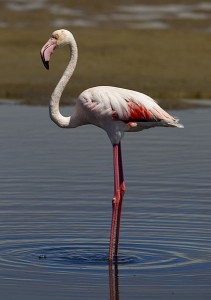
On the 15th and 16th April we had one of my favourite events at Trinity College Dublin: the annual School of Natural Sciences Postgraduate Symposium. Over the course of two days many of our PhD students presented their work to the School. We also had two amazing plenary talks from Dr Nick Isaac (CEH) and Professor Jennifer McElwain (UCD). For those of you who are interested in exactly what we work on here at EcoEvo@TCD, here are the abstracts from the PhD student presentations. Check out the TCD website for more details! Continue reading “School of Natural Sciences Postgraduate Symposium: Part 2/4”
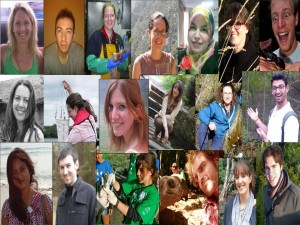
On the 15th and 16th April we had one of my favourite events at Trinity College Dublin: the annual School of Natural Sciences Postgraduate Symposium. Over the course of two days many of our PhD students presented their work to the School. We also had two amazing plenary talks from Dr Nick Isaac (CEH) and Professor Jennifer McElwain (UCD). For those of you who are interested in exactly what we work on here at EcoEvo@TCD, here are the abstracts from the PhD student presentations. Check out the TCD website for more details! Continue reading “School of Natural Sciences Postgraduate Symposium: Part 1/4”
The University of Exeter team visited Ireland this week as part of their ongoing investigation into the biology of the Brent Goose. This species has a remarkable migration, spanning from Northern Canada to Western Europe. The team collects DNA samples, blood for stable isotope analysis and various morphometric and behavioural data. We joined them on Wednesday to help out.
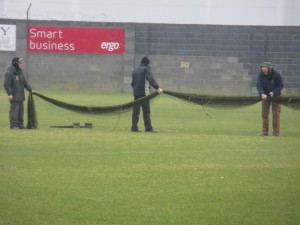
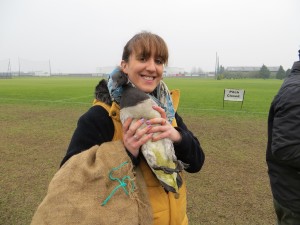
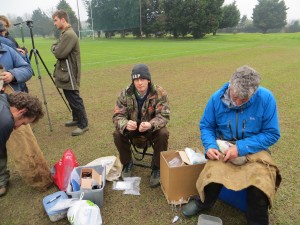
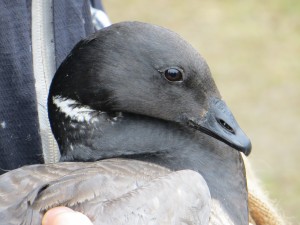
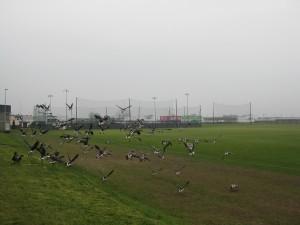
Author
Adam Kane: kanead[at]tcd.ie
Photo credit
Adam Kane
*by parasites here I am referring to all kinds of infectious disease causing agents including bacteria, viruses, fungi, protozoa, helminths and arthropods.
Why do we care about primate parasites?
Many of the most devastating infectious diseases in humans have origins in wildlife. For example, the global AIDS pandemic originated through human contact with wild African primates and influenza viruses circulate among wild bird populations. These are not only historical occurrences. Recently, for example, rodents were identified as the source of a Hantavirus outbreak in Yosemite National Park, USA . As human populations continue to expand into new areas and global changes in temperature and habitat alter the distributions of wild animals, humans around the world will have greater contact with wildlife. Thus, understanding which infectious agents have the potential to spread from animals to humans is crucial for preventing future human disease outbreaks.
Many efforts are being made to collate information on wildlife and human diseases. Much of my research (which I will blog about when I get chance!) uses an amazing database known as the Global Mammal Parasite Database or GMPD for short. Every time a paper is published which contains details of parasites found in either primates, carnivores or ungulates, the information is added to the database. As much data as possible is recorded, including the species infected, the type of parasite, the prevalence of the parasite, and the geographic location of the study. Prof. Charles Nunn and his colleagues have been collecting data for the GMPD since around 2005 and it currently contains around 6000 records for primates alone. This definitely makes it the most comprehensive dataset of primate parasites in existence.
The GMPD sounds amazing…so what’s the problem?
The problem with the GMPD (and this is a feature of virtually all datasets) is that there is sampling bias. Certain primates are sampled for parasites much more frequently than others. Chimpanzees, for example, are sampled for parasites all the time, whereas species such as tarsiers are sampled much less often. This has the effect of making it look like chimpanzees have far more parasites than tarsiers, simply because they have been sampled more often. In analyses using the database we usually deal with this problem by adding sampling effort into our models, so we give less emphasis to high numbers of parasites in primates we have lots of samples for. Unfortunately this problem is also evident when we look at parasites (things like malarial parasites are often sampled because of their importance to human health) and geographic regions (areas with primate research stations are sampled far more regularly than more remote regions). If we hope to use the GMPD data to make reliable predictions about future risks to humans, we need to identify gaps in our knowledge of primate parasites.
So what did you do?
Without going into the technical details, we looked across the primate phylogeny and primate geographic ranges to identify gaps in our knowledge, and used statistical models to investigate what factors led to primates and geographic areas being relatively well- or relatively poorly-sampled. We also used species accumulation curves to extrapolate parasite species richness for primates.
Where are the gaps in our knowledge?
We found that apes (chimpanzees, gorillas and orangutans) were generally better-sampled than other primates, but there was incredible variation in sampling among all other major primate groups. Apart from apes, the primates that researchers appear to sample most are the species they encounter most often, i.e., widespread, terrestrial, diurnal species. However, some primates were sampled more often because they are already intensively studied for other research, because they live in frequently visited field sites, or because of their importance in medical research. Across countries, we found that in general, parasite sampling is highest in countries with more primates to sample. We expected that the GDP of the countries would also affect sampling effort, with wealthier countries having more money for disease monitoring. However, we found no evidence for this in our analyses, probably because most research on primate diseases is not funded by the country in which the research takes place.
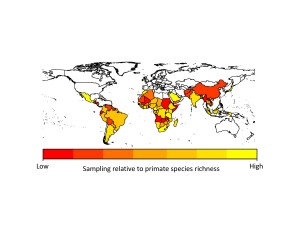
When we extrapolated parasite species richness values we found that even within our best-sampled primates and countries, we are missing a lot of parasites. On average we predicted that 38-79% more parasite species than currently reported in the GMPD should be found in our best sampled primate species, and 29-40% more parasite species than currently reported in the GMPD should be found in our best sampled countries. This emphasizes exactly how poor our sampling is across all primates and countries. Another concern is that although viruses make up only 12% of the parasites in our dataset, viruses arguably present the greatest zoonotic disease threat to humans because their fast rates of evolution should allow them to easily adapt to new hosts.
What next?
Identifying parasite sampling gaps across primate species and geographic regions is only the first step; we need to find strategies to minimize these sampling gaps if we are to predict which primate diseases may emerge in humans. One solution is to set research priorities based on the sampling gaps, for example, by focusing effort and funding on relatively poorly-sampled primate species, arboreal primates, those with small geographic ranges, or those found in relatively poorly-sampled regions of South East Asia, Central and Western Africa, and South America.
Focusing on relatively poorly-sampled primate species and areas may improve our general understanding of primate parasites, but it is only one factor in predicting risk to humans. For example, hosts are more likely to share parasites with their close relatives than with more distant relatives. Thus, continuing to focus our sampling efforts on parasites of our closest relatives (chimpanzees, gorillas and orangutans) may provide the greatest return in the case of risks to humans. This is particularly important because we found that chimpanzees are expected to have 33-50% more parasites than currently found in the GMPD. In addition, ecological similarities also influence parasite sharing among primates, and humans share more parasites with terrestrial than arboreal primate species. As with sampling effort, this probably reflects higher contact rates among humans and terrestrial primates compared to arboreal primates. As a related issue, a host living at higher density is expected to have higher prevalence of parasites and may have more contact with human populations or our domesticated animals, thus increasing opportunities for host shifts to humans. The large numbers of zoonotic emerging infectious diseases with rodent or domesticated animal sources also highlight the importance of rates of contact and host density for disease emergence in humans.
In conclusion Sampling effort for primate parasites is uneven and low. The sobering message is that we know little about even the best studied primates, and even less regarding the spatial and temporal distribution of parasitism within species. Much more sampling is needed if we hope to predict or prevent future emerging infectious diseases outbreaks.
Author
Natalie Cooper
nhcooper123
ncooper[at]tcd.ie
Photo credit
Natalie Cooper, wikimedia commons
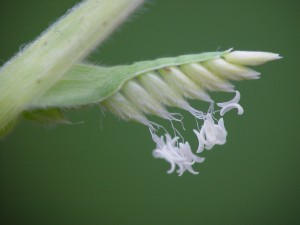
Statistical modeling indicates that C4 evolvability strongly increases when a particular type of anatomy (proportion of vascular bundle sheath) reaches 15%. A reduction in the distance between the bundle sheaths occurred before the evolution of the C4 grass group but not in other groups of grasses which lack the C4 trait. Therefore, when environmental changes promoted C4 evolution, suitable anatomy was present only in members of this group, explaining the clustering of C4 origins in this group. These results show that key alterations of leaf anatomy facilitated the repeated evolution of one of the most successful physiological innovations in flowering plant history.
Author
Trevor Hodkinson: hodkinst
Photo credit
Trevor Hodkinson
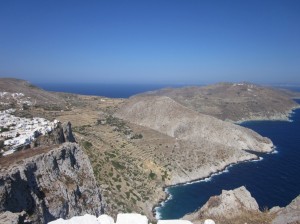
One of the many things I love about Zoology is the opportunity to work away from a desk. As an undergraduate I enjoyed field courses and summer projects in the not so exotic wilds of Ireland and Cambridgeshire – great experiences but not quite a match for the glamour of the recent TCD trip to Kenya! Last summer, however, I was fortunate enough to expand my zoological horizons by working as a field assistant in the Greek Islands.
I travelled to the remote island of Folegandros, one of the quieter tourist destinations in the Cyclades, to assist Kate Marshall, a PhD student in Behavioural Ecology at the University of Cambridge (supervised by Dr. Martin Stevens and Professor Nick Davies). Kate’s research focuses on the evolution of morphological and colouration phenotypic divergences in Erhard’s wall lizards (Podarcis erhardii). She is particularly interested in studying the roles of both natural selection (adaptations to avoid predators) and sexual selection (signals to other lizards) in driving the evolution of varied colour patterns in lizard populations on different islands.
Kate is modelling the lizards’ colouration from the perspectives of predators (birds) and conspecifics (other lizards). Some of her early results indicate that P. erhardii populations have evolved colour patterns and behaviours that are locally adapted to different island environments. Dorsal and head colour patterns seem to be well matched to the lizards’ local environments- indicating a possible function in predator avoidance – while the lizards’ sides are brightly coloured and may play roles in conspecific signalling and sexual selection (Fig. 1).
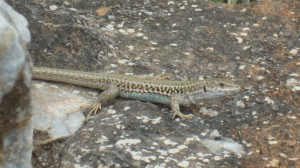
Some of the most enjoyable parts of my time in Greece involved trying out the unusual techniques which form part of Kate’s research methods. For example, I helped her conduct a pilot study to assess whether predator attacks on the lizards might vary in different islands. This involved making 3D lizards out of modelling clay, distributing them across line transects and checking them for signs of predator attacks such as rodent bite marks. The whole process attracted a few curious looks from the locals as we marched through town with boxes of clay lizards! However, these glances were nothing compared to the reactions elicited by our lizard wrangling attempts. Using an extendable fishing rod, dental floss and noose-tying know-how, we patrolled the island’s hiking paths trying to catch unsuspecting sunbathing lizards by slipping the noose around their necks. The technique was successful in some of Kate’s other field sites but unfortunately we had no such luck during my time – just some very confused stares from locals and tourists as we slowly “fished” our way down the mountain side!
I thoroughly enjoyed my time helping out in Greece. The project covers an interesting area of evolutionary biology – studying the often conflicting influences of both natural and sexual selection in driving phenotypic divergences within species. It was also a great learning experience because it gave me an insight into some of the details and challenges involved in planning a PhD before I started my own project. Finally (and perhaps most importantly), it wasn’t all hard work – combining fieldwork with swimming in the clear blue Aegean or afternoons at the beach were just further confirmations that you can’t beat the perks of being a Zoology student!
Author
Sive Finlay: sfinlay[at]tcd.ie
Photo credit
Sive Finlay, K. Marshall